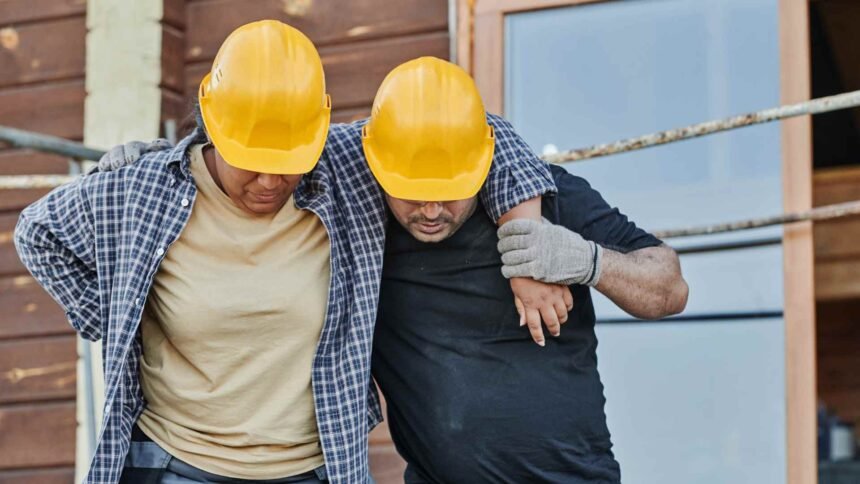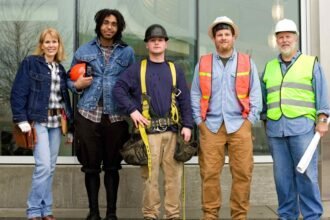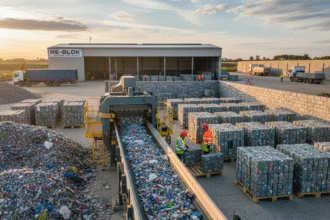In the fast-paced world of construction, where deadlines loom and labor shortages bite hard, companies often share workers to keep projects moving. But what happens when one of these “borrowed” employees slips off a scaffold or suffers a serious fall? A recent surge in such cases has spotlighted a thorny legal question: Who pays the price? As the industry grapples with ongoing worker shortages in 2025, experts warn that unclear liabilities could lead to costly lawsuits and stalled builds. Construction firms increasingly turn to subcontractors and temp agencies to fill gaps, but this practice layers on risks that demand attention.
This issue hit the headlines again this week, with legal analysts pointing to the “borrowed employee doctrine” as a key factor in determining fault. In simple terms, when a worker from one company lends a hand to another, the borrowing firm often shoulders the responsibility for safety and any injuries. Yet, the details vary by state, contract terms, and who truly calls the shots on site. Industry leaders stress that without clear agreements, everyone involved could face financial headaches.
Defining the Borrowed Employee
Construction teams “borrow” workers when one employer temporarily lends staff to another, usually with everyone’s agreement. The lender worker follows the borrower’s directions while on the job. For example, a general contractor might pull in electricians from a sub to speed up wiring on a high-rise. This setup helps plug holes in crews, especially amid the 2025 labor crunch driven by immigration checks and retiring skilled tradespeople.
Attorney Carol Sigmond, a partner at Greenspoon Marder in New York, explains that courts often label these workers as “special employees.” This shifts liability to the borrower, but only if they exercise real control. “The rules differ slightly from state to state,” Sigmond notes. Sometimes, firms use this to shield bigger companies from claims by routing blame to smaller, less solvent entities. It’s a tactic that courts scrutinize closely, looking at how much the original employer still influences the work.
Facts from recent reports show borrowed workers now make up a larger slice of jobsite crews than ever. With projects booming in urban areas like New York and Florida, this trend exposes more people to hazards like falls, which account for nearly half of construction fatalities. The Occupational Safety and Health Administration (OSHA) reported over 4,000 worker deaths in 2017, with falls leading the pack—a statistic that hasn’t improved much since.
Untangling Liability: Who Pays When Things Go Wrong?
When a borrowed worker gets hurt, fingers point in multiple directions. The borrowing contractor typically holds liability because they direct the daily tasks. “The contractor supervising the borrowed employee bears responsibility for their safety, unless the contract says otherwise,” says construction attorney Jennifer Moffatt. General contractors or owners must ensure the whole site stays safe for everyone, borrowed or not.
State laws add twists. In Florida, courts start by assuming the worker belongs to their original employer. The borrower must prove otherwise by showing a contract exists, the injury happened during their work, and they controlled the details. Matthew Koskinen, an attorney at Dickinson Wright in Fort Lauderdale, emphasizes that clear agreements are crucial. “Factors like who provides tools and who sets the scope matter a lot,” he adds.
Workers’ compensation often enters the picture first. Most states require employers to carry this insurance, which covers injuries without proving fault. But for borrowed workers, it gets tricky: The policy might come from the lender or the borrower. Attorney Adam Richards from Dickinson Wright advises checking coverage upfront. “If the lending employer provides it, great—but the borrower should confirm and have backups,” he says. Without it, personal injury lawsuits could follow, seeking damages for medical bills, lost wages, and pain.
Real cases illustrate the stakes. In one Florida dispute last year, a borrowed scaffolder fell due to faulty equipment. The court ruled the borrowing firm liable because it supplied the gear and oversaw the setup. The payout topped $500,000, highlighting how control equals responsibility.
Expert Advice: Navigating the Legal Maze
Legal pros urge caution. Sigmond warns that firms sometimes hide behind shell companies to dodge big payouts. “Courts dig into the control level to prevent that,” she says. Koskinen agrees, recommending layered contracts that spell out insurance, indemnity, and remedies if coverage lapses.
Moffatt pushes for transparency: Require subs to flag borrowed workers. “Contracts must detail who’s in charge of payroll, tools, and safety,” she advises. This prevents surprises when accidents strike.
Beyond the law, human factors play in. Workers face real dangers—slippery roofs, heavy machinery—and borrowing amplifies confusion over who trains them or supplies gear. A 2024 study by the Bureau of Labor Statistics noted construction injuries rose 5% amid shortages, with temps hit hardest.
Best Practices to Shield Your Business
Smart contractors take steps to minimize risks. First, vet subs thoroughly: Check licenses, insurance, and past claims. Demand certificates proving workers’ comp covers borrowed staff.
Second, craft ironclad contracts. Outline responsibilities clearly—who oversees what, who pays for what. Include clauses on disclosing borrowed workers and shared liability.
Third, prioritize safety training. Even for temps, ensure everyone knows site hazards. Regular inspections and gear checks save lives and lawsuits.
Homeowners aren’t off the hook either. If hiring directly, they could face claims under premises liability if they ignore dangers like unstable floors. Experts like those at Grey Law in Los Angeles stress warning workers of hidden risks.
Finally, consult attorneys early. “Don’t wait for an injury—plan ahead,” Richards urges. This proactive stance protects wallets and workers alike.
The Bigger Picture: Safety First in a Short-Staffed Industry
As construction booms, borrowed workers keep the wheels turning. But injuries expose cracks in the system, from fuzzy contracts to varying state rules. By clarifying roles and beefing up protections, firms can build safer sites and avoid legal pitfalls. Ultimately, it’s about people: Ensuring every worker, borrowed or not, heads home safe. With labor woes persisting into 2025, addressing these liabilities isn’t just smart—it’s essential for the industry’s future. In the fast-paced world of construction, where deadlines loom and labor shortages bite hard, companies often share workers to keep projects moving. But what happens when one of these “borrowed” employees slips off a scaffold or suffers a serious fall? A recent surge in such cases has spotlighted a thorny legal question: Who pays the price? As the industry grapples with ongoing worker shortages in 2025, experts warn that unclear liabilities could lead to costly lawsuits and stalled builds. Construction firms increasingly turn to subcontractors and temp agencies to fill gaps, but this practice layers on risks that demand attention.
This issue hit the headlines again this week, with legal analysts pointing to the “borrowed employee doctrine” as a key factor in determining fault. In simple terms, when a worker from one company lends a hand to another, the borrowing firm often shoulders the responsibility for safety and any injuries. Yet, the details vary by state, contract terms, and who truly calls the shots on site. Industry leaders stress that without clear agreements, everyone involved could face financial headaches.
Defining the Borrowed Employee
Construction teams “borrow” workers when one employer temporarily lends staff to another, usually with everyone’s agreement. The lender worker follows the borrower’s directions while on the job. For example, a general contractor might pull in electricians from a sub to speed up wiring on a high-rise. This setup helps plug holes in crews, especially amid the 2025 labor crunch driven by immigration checks and retiring skilled tradespeople.
Attorney Carol Sigmond, a partner at Greenspoon Marder in New York, explains that courts often label these workers as “special employees.” This shifts liability to the borrower, but only if they exercise real control. “The rules differ slightly from state to state,” Sigmond notes. Sometimes, firms use this to shield bigger companies from claims by routing blame to smaller, less solvent entities. It’s a tactic that courts scrutinize closely, looking at how much the original employer still influences the work.
Facts from recent reports show borrowed workers now make up a larger slice of jobsite crews than ever. With projects booming in urban areas like New York and Florida, this trend exposes more people to hazards like falls, which account for nearly half of construction fatalities. The Occupational Safety and Health Administration (OSHA) reported over 4,000 worker deaths in 2017, with falls leading the pack—a statistic that hasn’t improved much since.
Untangling Liability: Who Pays When Things Go Wrong?
When a borrowed worker gets hurt, fingers point in multiple directions. The borrowing contractor typically holds liability because they direct the daily tasks. “The contractor supervising the borrowed employee bears responsibility for their safety, unless the contract says otherwise,” says construction attorney Jennifer Moffatt. General contractors or owners must ensure the whole site stays safe for everyone, borrowed or not.
State laws add twists. In Florida, courts start by assuming the worker belongs to their original employer. The borrower must prove otherwise by showing a contract exists, the injury happened during their work, and they controlled the details. Matthew Koskinen, an attorney at Dickinson Wright in Fort Lauderdale, emphasizes that clear agreements are crucial. “Factors like who provides tools and who sets the scope matter a lot,” he adds.
Workers’ compensation often enters the picture first. Most states require employers to carry this insurance, which covers injuries without proving fault. But for borrowed workers, it gets tricky: The policy might come from the lender or the borrower. Attorney Adam Richards from Dickinson Wright advises checking coverage upfront. “If the lending employer provides it, great—but the borrower should confirm and have backups,” he says. Without it, personal injury lawsuits could follow, seeking damages for medical bills, lost wages, and pain.
Real cases illustrate the stakes. In one Florida dispute last year, a borrowed scaffolder fell due to faulty equipment. The court ruled the borrowing firm liable because it supplied the gear and oversaw the setup. The payout topped $500,000, highlighting how control equals responsibility.
Expert Advice: Navigating the Legal Maze
Legal pros urge caution. Sigmond warns that firms sometimes hide behind shell companies to dodge big payouts. “Courts dig into the control level to prevent that,” she says. Koskinen agrees, recommending layered contracts that spell out insurance, indemnity, and remedies if coverage lapses.
Moffatt pushes for transparency: Require subs to flag borrowed workers. “Contracts must detail who’s in charge of payroll, tools, and safety,” she advises. This prevents surprises when accidents strike.
Beyond the law, human factors play in. Workers face real dangers—slippery roofs, heavy machinery—and borrowing amplifies confusion over who trains them or supplies gear. A 2024 study by the Bureau of Labor Statistics noted construction injuries rose 5% amid shortages, with temps hit hardest.
Best Practices to Shield Your Business
Smart contractors take steps to minimize risks. First, vet subs thoroughly: Check licenses, insurance, and past claims. Demand certificates proving workers’ comp covers borrowed staff.
Second, craft ironclad contracts. Outline responsibilities clearly—who oversees what, who pays for what. Include clauses on disclosing borrowed workers and shared liability.
Third, prioritize safety training. Even for temps, ensure everyone knows site hazards. Regular inspections and gear checks save lives and lawsuits.
Homeowners aren’t off the hook either. If hiring directly, they could face claims under premises liability if they ignore dangers like unstable floors. Experts like those at Grey Law in Los Angeles stress warning workers of hidden risks.
Finally, consult attorneys early. “Don’t wait for an injury—plan ahead,” Richards urges. This proactive stance protects wallets and workers alike.
The Bigger Picture: Safety First in a Short-Staffed Industry
As construction booms, borrowed workers keep the wheels turning. But injuries expose cracks in the system, from fuzzy contracts to varying state rules. By clarifying roles and beefing up protections, firms can build safer sites and avoid legal pitfalls. Ultimately, it’s about people: Ensuring every worker, borrowed or not, heads home safe. With labor woes persisting into 2025, addressing these liabilities isn’t just smart—it’s essential for the industry’s future.









